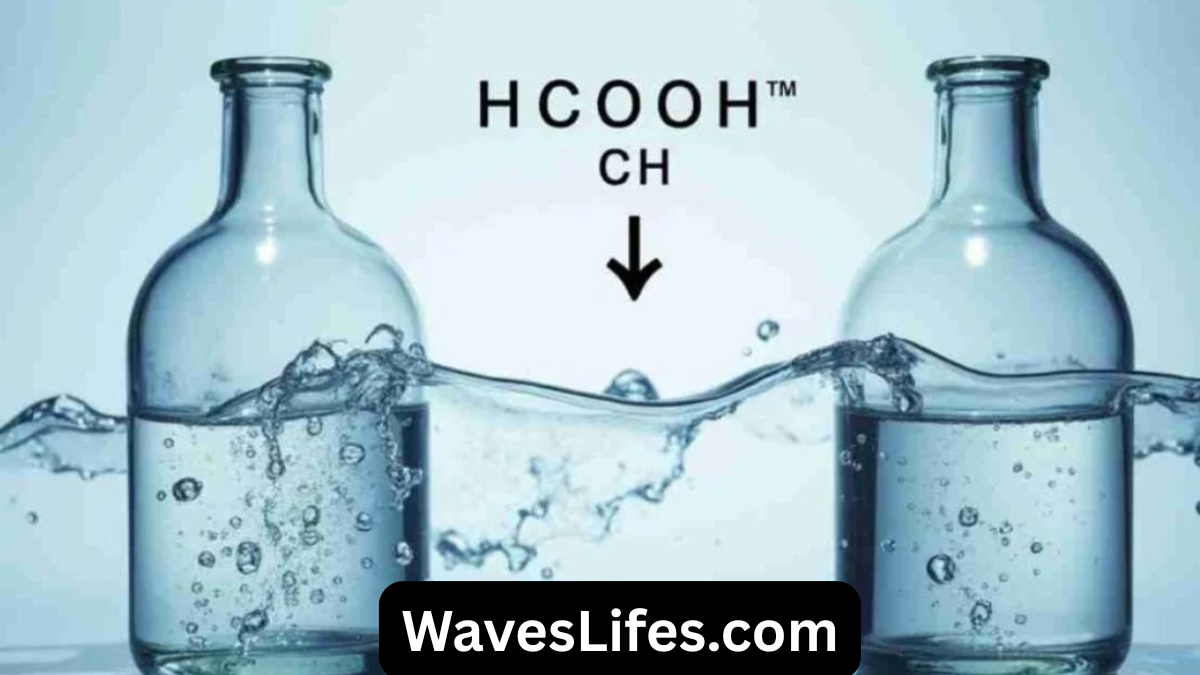HCOOCH CH2 H2O Chemistry often brings together diverse compounds that interact in fascinating ways. When analyzing a set of chemical species like HCOOH, CH₂, and H₂O, it is essential to explore their individual characteristics, interactions, and relevance in scientific and industrial contexts. These compounds are connected by fundamental principles of organic and inorganic chemistry. Understanding their structure, reactivity, and uses provides a foundational insight into molecular behavior and broader chemical applications.
The Molecular Identity of HCOOH
HCOOH, commonly known as formic acid, is the simplest carboxylic acid. It comprises a carboxyl group attached to a single hydrogen atom. Its structure can be written as H–COOH. Formic acid is a colorless liquid with a pungent odor and is miscible with water and most polar organic solvents. It occurs naturally in the stings and bites of many insects, including ants, from which its name is derived (“formica” is Latin for ant).
Formic acid plays an essential role in chemical synthesis and biological systems. It is often used as a preservative and antibacterial agent in livestock feed. Its acidic nature allows it to participate in hydrogen bonding, making it soluble in water and other polar solvents. In chemical reactions, formic acid is known for its ability to act as both an acid and a HCOOCH CH2 H2O Reducing agent, making it versatile in redox chemistry and catalysis.
Exploring CH₂: The Methylene Group
CH₂ refers to the methylene group, a common structural motif in organic molecules. While CH₂ does not exist as a stable molecule by itself under normal conditions, it appears frequently as a bridging unit in hydrocarbons. For example, in alkanes, the –CH₂– group connects other carbon atoms, forming chains of varying lengths.
In a reactive context, CH₂ can refer to the methylene carbene (CH₂), a divalent carbon species with two unpaired electrons. Methylene carbene is highly reactive and typically appears in organic reaction mechanisms as an intermediate. Its presence is critical in various reactions such as cyclopropanation and insertion into C–H bonds. Due to its transient nature, methylene is usually generated in situ during reactions and rarely isolated.
H₂O: The Universal Solvent
H₂O, or water, is arguably the most important chemical substance for life on Earth. It is a simple molecule consisting of two hydrogen atoms covalently bonded to one oxygen atom. Despite its simplicity, water exhibits remarkable physical and chemical properties. Its high polarity and ability to form extensive hydrogen bonds make it an excellent solvent for a wide range of substances.
Water plays a central role in chemical reactions, especially those in biological systems. It acts as both a reactant and a product in numerous reactions, including hydrolysis, condensation, and redox processes. Its thermal properties and ability to moderate temperature fluctuations are critical in both natural ecosystems and industrial settings.
Interactions Between HCOOH, CH₂, and H₂O
Understanding the interplay between formic acid, methylene, and water involves a look into various reaction types and mechanisms. In aqueous solutions, formic acid partially dissociates to release hydrogen ions and formate anions. This behavior contributes to its role as a weak acid. The presence of water facilitates this dissociation due to its polarity and hydrogen bonding capabilities.
If CH₂ is present in a reactive form such as methylene carbene, it can interact with formic acid under controlled conditions. These interactions may involve the insertion of CH₂ into bonds or abstraction of hydrogen atoms, leading to the formation of new compounds. However, due to CH₂’s high reactivity and instability, such reactions typically occur under laboratory-controlled environments, often catalyzed by transition metals or photochemical methods.
Water also serves as a reaction medium in these processes, providing a polar environment that stabilizes ionic intermediates and facilitates proton transfer. Additionally, water’s ability to act as both an acid and base makes it a participant in buffer systems when mixed with weak acids like formic acid.
Industrial Applications of These Molecules
In industrial chemistry, formic acid is employed in a variety of processes. It is used in leather tanning, dyeing, and as a coagulant in rubber production. One of its growing uses is in fuel cells, particularly in direct formic acid fuel cells (DFAFCs), where it serves as a liquid fuel alternative due to its ability to release hydrogen in a controlled manner.
The methylene group is fundamental in the construction of polymers, especially polyethylene and polypropylene, where repeating –CH₂– units create long chains of carbon atoms. These polymers are crucial in packaging, textiles, and plastic products.
Water’s industrial utility is vast. It acts as a coolant in power plants, a solvent in chemical synthesis, and a cleaning agent in numerous manufacturing processes. Its role in thermoregulation and solubilization of compounds is indispensable across nearly all sectors of chemical engineering and production.
Environmental Considerations
Each of these compounds also comes with environmental implications. Formic acid, although biodegradable and generally considered to have low toxicity, can still contribute to acidification if released in large quantities. It is also produced naturally in biomass burning and as a secondary pollutant in atmospheric chemistry.
Methylene, due to its fleeting nature, does not persist in the environment. However, reactions involving methylene intermediates may yield byproducts that require careful handling.
Water, though a renewable resource, is under increasing pressure due to industrial consumption and pollution. Maintaining water quality while ensuring adequate supply for chemical and manufacturing processes is a critical challenge in sustainable development.
Scientific Research and Advances
Recent research has focused on optimizing the use of formic acid in energy applications. Scientists are exploring catalysts that can efficiently decompose formic acid into hydrogen and carbon dioxide for use in hydrogen storage and fuel cell technologies. This application supports clean energy goals by providing an efficient, liquid-based hydrogen source.
In the realm of synthetic organic chemistry, methylene groups continue to play a role in innovative synthesis techniques. Novel catalysts and reaction conditions are being developed to safely harness methylene’s reactivity for constructing complex organic molecules, including pharmaceuticals and agrochemicals.
Water continues to be the focus of research in fields like green chemistry, where scientists aim to use water as a solvent to reduce environmental impact. The development of water-tolerant catalysts and aqueous-phase reactions is making chemical processes safer and more sustainable.
Educational Importance
Understanding the chemistry of HCOOH, CH₂, and H₂O is foundational in both high school and university-level education. These compounds are introduced early due to their representative behavior of functional groups (carboxylic acids), reactive intermediates (carbenes), and solvents (water). Through their study, students learn critical concepts such as acid-base behavior, molecular bonding, reaction mechanisms, and solvent effects.
Laboratory experiments involving formic acid titrations, synthesis involving methylene derivatives, and aqueous solubility studies of various compounds using water help reinforce theoretical learning with practical application. Their inclusion in textbooks and teaching curricula highlights their pedagogical value.
Molecular Geometry and Bonding
Formic acid has a planar structure, with the carbon atom forming three sigma bonds: one with the hydrogen atom, one with the hydroxyl group, and one with the carbonyl oxygen. The molecule also exhibits resonance, as the electrons in the C=O and C–OH bonds can delocalize, giving the molecule additional stability.
Methylene, when considered as a carbene, exists in two electronic states: singlet and triplet. In the singlet state, the electrons are paired in one orbital, while in the triplet state, the electrons are in separate orbitals with parallel spins. The singlet state is more reactive and often participates in electrophilic reactions.
Water has a bent molecular geometry due to the two lone pairs of electrons on oxygen. This results in a bond angle of approximately 104.5°, contributing to water’s unique physical properties like high boiling point and surface tension.
Potential Health and Safety Considerations
Formic acid, despite being naturally occurring, is corrosive in concentrated forms. It can cause burns and irritation upon contact with skin and mucous membranes. Proper handling using gloves, goggles, and ventilation is necessary when working with concentrated solutions.
Methylene is generally not encountered in pure form due to its instability, but intermediates or reagents that generate CH₂ require caution. They are often toxic or flammable, necessitating strict laboratory protocols.
Water is generally safe, but in industrial and laboratory settings, its role as a solvent means it can carry dissolved hazardous materials. Additionally, water used in processes must often be deionized or distilled to prevent unwanted chemical interactions.
Future Outlook
As the chemical industry evolves toward sustainability and efficiency, molecules like HCOOH, CH₂, and H₂O will remain central to innovation. From green solvents to fuel alternatives and synthetic chemistry, their role is poised to expand. New methods of utilizing formic acid for carbon capture and storage, or CH₂ as a safer reaction intermediate, could unlock significant advances in clean energy and medicine.
Water will continue to be at the heart of sustainable chemistry, both as a reactant and as an environmentally benign medium for reaction processes. The increasing integration of these substances into clean technology solutions underscores their ongoing relevance in addressing global challenges.
Frequently Asked Questions (FAQs)
What is HCOOH and where is it found?
HCOOH is formic acid, a naturally HCOOCH CH2 H2O occurring carboxylic acid found in ant venom, stinging nettles, and as a byproduct in various industrial processes.
Is CH₂ a stable molecule?
No, CH₂ usually exists as a reactive intermediate called methylene carbene and is not stable under normal conditions. It often appears briefly during certain chemical reactions.
Why is water (H₂O) called the universal solvent?
Water is called the universal solvent because it can dissolve more substances than any other liquid due to its polar nature and hydrogen bonding capabilities.
Can formic acid be used as fuel?
Yes, formic acid is being researched and used as a hydrogen source in direct formic acid fuel cells, offering a cleaner alternative fuel option.
Are there health risks associated with HCOOH?
Yes, concentrated formic acid is corrosive and can cause burns or irritation. It should be handled with proper protective equipment in controlled environments.
What is the role of water in chemical reactions?
Water acts as a solvent, a medium for reactions, and can also participate in hydrolysis and redox reactions depending on the context.
Can CH₂ be isolated in a laboratory?
CH₂, in the form of methylene carbene, is extremely reactive and cannot be isolated under normal conditions. It is typically generated in situ during specific reactions.





